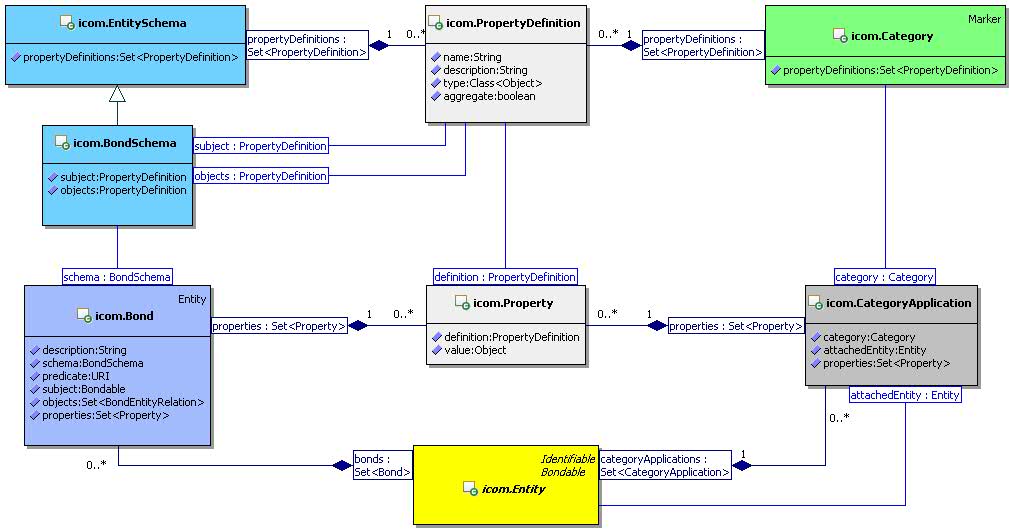Minutes of ICOM TC Meeting, February 17, taken by Eric S.
Chan
Agenda
1. Roll Call
2. Approve draft minutes from Feb 3 TC Meeting
3. Review the concomitant representation of
Bond in UML and RDF
4. Review Laura and Deidre’s proposal for
structuring ICOM Spaces
5. Drafting ICOM specification in OASIS
templates
6. AOB
1. The following eligible members were present
Laura Dragan
Eric Chan
2. Approve draft minutes from Feb 3 TC Meeting
Approval was deferred.
3. Review the concomitant representation of
Bond in UML and RDF
We revised the model of Bond (see figure below) to include
the BondSchema and PropertyDefinition for specifying the type of the subject
and objects of the bond, as well as any extensible properties in the bond. The
extensible properties can represent the annotation, provenance, and attribution
information.

The reification statements serve as the conceptual framework
for isomorphic mapping of Bond objects between UML and RDF representations. We
note that it is often not necessary to materialize the reification statements since
the primary objective should be to translate the bond entity relations to the
RDF triples rather than to the reification of the triples.
The following examples provided the context for the
discussions.
The RDF triples comprising an n-ary
relation associate the same subject and property with n-1 values. For
example, the tertiary relation “Project-SubUnit(Project, SP1, SP2)”
between a project and two subprojects is represented by two triples <Project
hasSubUnit SP1> and <Project hasSubUnit SP2> that
associate the subject “Project” and property “hasSubUnit”
with the objects SP1 and SP1.
As a counterpart to the RDFS vocabulary
for specifying the domain and range of a property, we introduced BondSchema
and PropertyDefinition to specify the types of the properties represented by the
bonds. For example, the BondSchema for “Project-SubUnit” bond can contain
two PropertyDefinition’s to specify the types of the “subject”
and “objects” attributes of the bond. The types of the “subject”
and “objects” attributes can represent, respectively, the domain and
range of “hasSubUnit” property. The PropertyDefinition for the “objects”
attribute specifies that the attribute is an aggregate.
The RDF reification statement can
add the annotation, provenance, and attribution information. For example, in the
following reification of the “hasSubUnit” property on the “Project”
space, the “Project-SubUnit” becomes a subject that has provenance information
“stipulatedBy” and “stipulatedOn” about the “hasSubUnit”
property on the “Project” space.
Project-SubUnit
rdf:type
rdf:Statement
Project-SubUnit
rdf:subject
Project
Project-SubUnit
rdf:predicate
hasSubUnit
Project-SubUnit
rdf:object
SP1
Project-SubUnit
rdf:object
SP2
Project-SubUnit
stipulatedBy Plan:85649
Project-SubUnit
stipulatedOn September 9, 2009
Provenance properties in the RDF
reification, besides the rdf:type, rdf:subject, rdf:predicate, and rdf:object properties
of the "reification quad," can be represented by an extensible set of
properties in the bond object. The range of the provenance property can be specified
by the type in the PropertyDefinition, however the domain of the properties are
implicitly specified by the bond schema, i.e. the type of the bond subject. For
example, the “Project-SubUnit” bond can contain two additional
properties for “stipulatedBy” and “stipulatedOn.” The property
definitions for “stipulatedBy” and “stipulatedOn” in
the bond schema for “Project-SubUnit” can specify “Project-Plan”
for the range of “stipulatedBy” property and Date for the range of “stipulatedOn”
property.
4. Review Laura and Deidre’s proposal for
structuring ICOM Spaces
Laura proposed that ICOM Space should support hierarchical
structures similar to the ICOM Community and Folder hierarchies. It should not
require Bond to represent subspace relationships. ICOM specification may treat Space
hierarchy as an optional feature.
5. Drafting ICOM specification in OASIS
templates
Discussion deferred.
6. AOB
Category and Bond provide the extensibility of classes and
properties for ICOM. In the RDF representation we define Bond as a subclass of
rdf:Statement, which is an instance of rdf:Class. If we define Category as a
subclass of rdf:Class, instances of Category are classes that can be applied to
an entity. A category application on an entity can be construed as a
classification of the entity.
A Category object can represent the domain or range of
properties. A Category object can hold the property definitions for the
properties whose domain is represented by the category object. The type in the PropertyDefinition
specifies the range of the property while the category object itself implicitly
specifies the domain of the property.
The following UML model for Category and CategoryApplication
shows that properties for the entities can be extended by attaching category
applications on the entities.

The Meeting was adjourned.